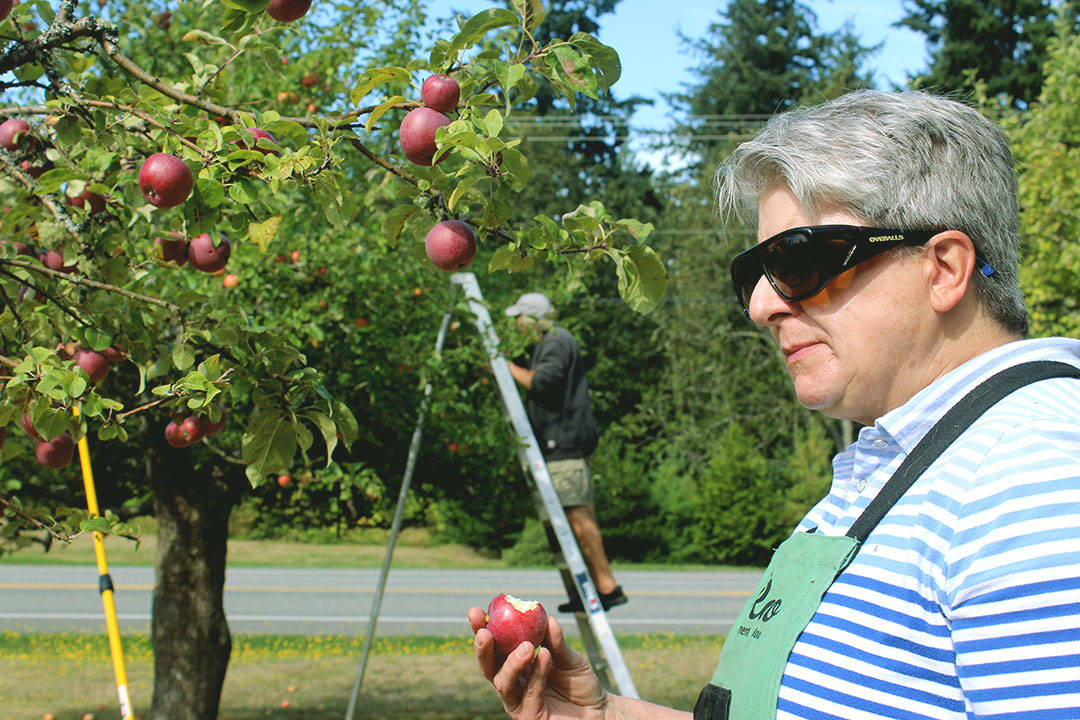There’s a saying in Italian cucinas that chefs must connect with the food by holding each ingredient in their own two hands.
If that’s the case, then many kitchens across South Whidbey get a jumpstart on the process by receiving earth offerings directly from the helping hands of community “gleaners.” Literally.
Merriam-Webster describes a gleaner as someone who gradually collects something bit by bit, or a person who gathers produce or grains after a harvest. The concept translates locally in the form of volunteer “Gleeful Gleaners” who spread out across the island to harvest fruit from laden trees and then deliver that bounty to the Good Cheer food bank in Bayview.
The Whidbey gleaners come from all walks of life and have one motive: to collect fruit from donated trees and get it into the hands of families and individuals with limited access to fresh, organic, locally grown fruit.
Volunteer tree-scouts keep an eye on donated fruit throughout the summer to determine when picking time is near. Then coordinators such as Brandi Blais at the gleaning program rally the picking troops and put out the call.
Blais arrived on Whidbey about a year and half ago as an AmeriCorps VISTA, or “Volunteer in Service to America.” She explains that AmeriCorps, which is similar to the Peace Corps but works only within the United States, will send workers such as herself to volunteer in a three-year project to get a gleaning program up and running.
On South Whidbey, the program supports the nonprofit Good Cheer food bank, which launched in 1962 and now provides food to an average of 864 local families every month. The organization’s thriving Good Cheer Garden supplements the summer gleanings with more than 5,000 pounds of fresh, pesticide-free produce grown every year.
A large portion of the food bank’s support arrives via revenue from its two thrift stores, one on Anthes Avenue in Langley and the other at Ken’s Corner. It also receives in-kind donations — including a $5,000 annual matching grant from Whidbey Island Bank — to ensure that families who count on school lunch programs during the school year can continue getting healthy food during the summer months.
The helping hands stretch even further into the community, Blais said.
“We take stuff to the veteran’s center, the senior center, Ryan’s House and different community partners when we have too much,” she said.
A gleaning last week at the home of Ray and Jacki Hovick brought volunteers such as Mary McMurty, a 20-year Whidbey Islander who has been part of the Gleeful Gleaners for several years. She said it’s just her small way of helping out.
Other pickers, such as Tom Schuch, are total newbies to the island, arriving in January of this year but quickly meshing with the network of community partners that include Whidbey Island farmers, agriculture apprentices, restaurateurs, gleaners and hundreds of other volunteers who get their hands dirty for a cause.
Good Cheer also recognizes the need to address root causes that contribute to hunger and families in need. Blaiss points out that even with the enormous accomplishments of the food bank in South Whidbey, the goal of “creating a hunger-free community” can feel elusive at times.
“It’s been more than 50 years, and we still have a food bank. Why is that?” she asks.
The harvest season is in full swing, so those who want to volunteer as gleaners, scouts, drivers or fruit-tree donors can reach out via the Good Cheer website. The Good Cheer food bank is open six days a week for those in need at 2812 Grimm Road in Langley.


